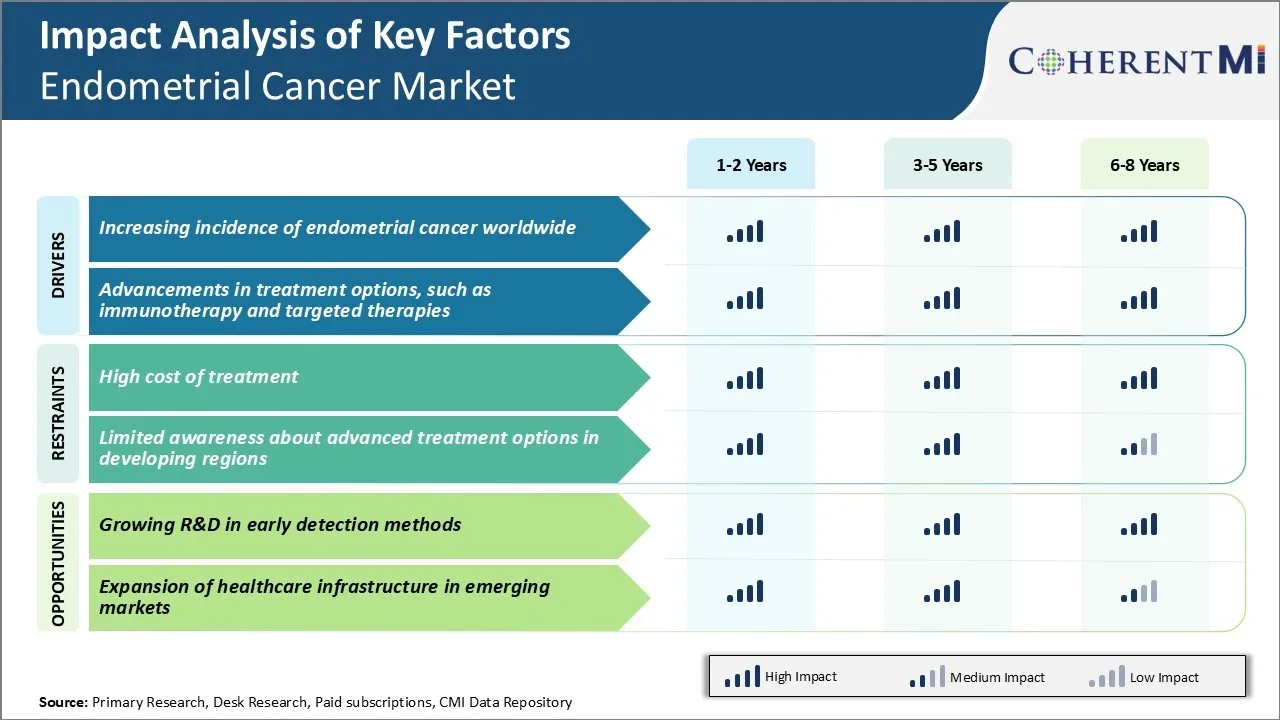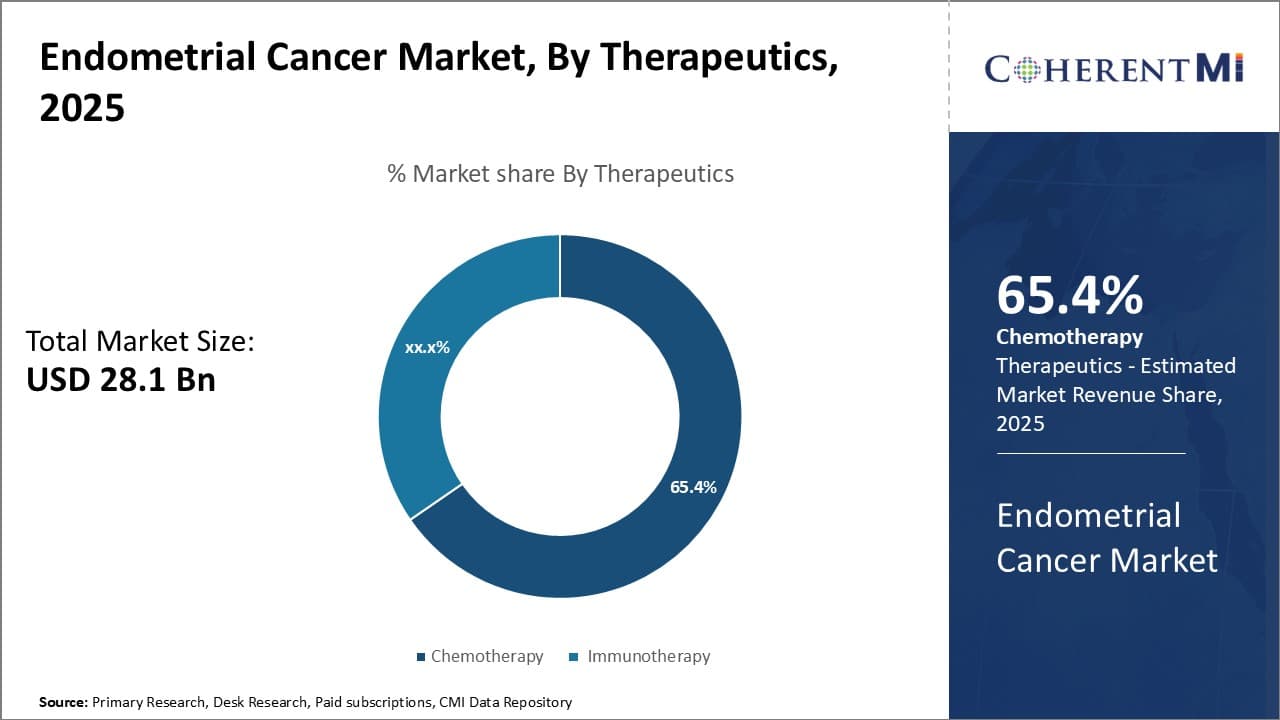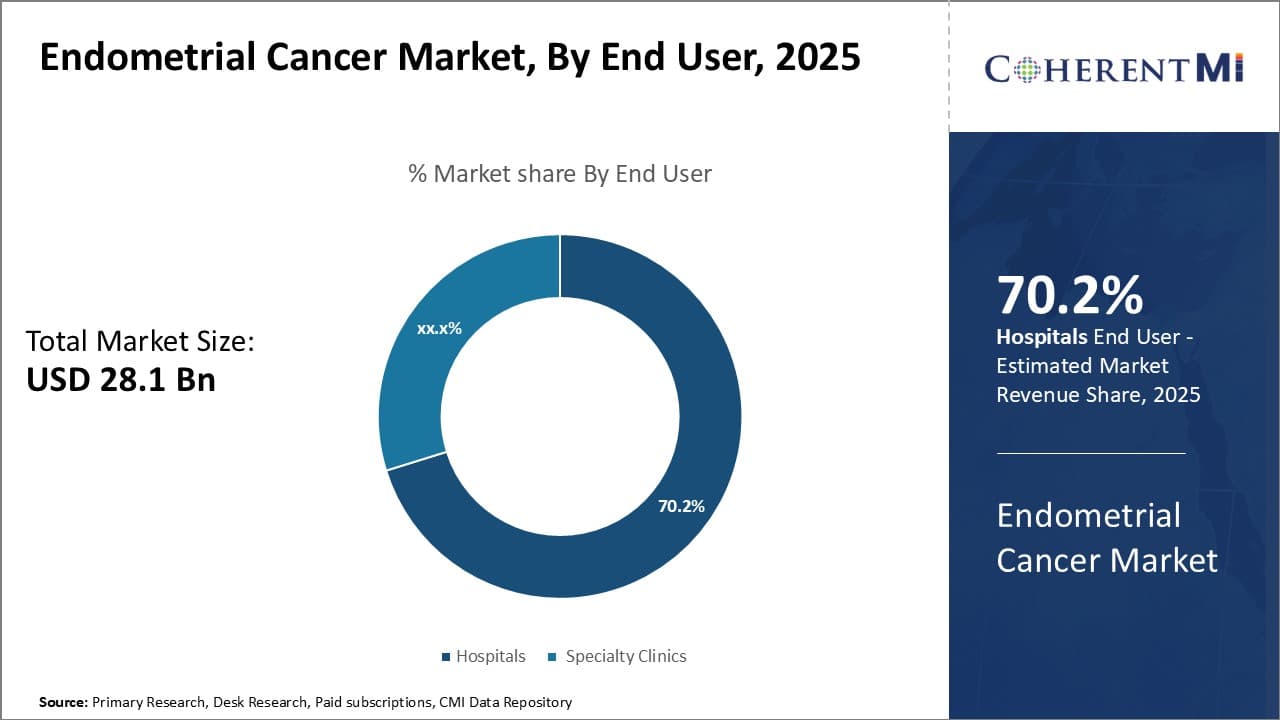

The endometrial cancer market is estimated to be valued at USD 28.10 Bn in 2025 and is expected to reach USD 41.97 Bn by 2032, growing at a compound annual growth rate (CAGR) of 5.9% from 2025 to 2032. This robust growth can be attributed to rising incidences of endometrial cancer cases worldwide owing to changing lifestyles and growing geriatric population.
Market Size in USD Bn
CAGR5.9%
| Study Period | 2025-2032 |
| Base Year of Estimation | 2024 |
| CAGR | 5.9% |
| Market Concentration | High |
| Major Players | GlaxoSmithKline Pharmaceuticals, Merck & Co, AstraZeneca, Karyopharm Therapeutics, Evergreen Therapeutics and Among Others |
Market Driver - Increasing Incidence of Endometrial Cancer Worldwide
As per medical experts studying cancer trends, factors such as the increasing prevalence of obesity and diabetes are contributing contributors to the spike in endometrial cancer incidence rates worldwide. With obesity affecting a huge population globally due to sedentary lifestyles and consumption of unhealthy diets, the potential patient pool suffering from endometrial cancer is expanding rapidly.
Another factor fueling the growth is increased life expectancy resulting in an aging population prone to cancer. Rising geriatric population susceptible to chronic diseases and cancers consequently enhances the target demographic for endometrial cancer treatment and diagnosis. Moreover, delayed childbearing and lesser pregnancies among women also contribute to hormonal imbalance elevating endometrial cancer occurrence as hormones produced during pregnancy offer some protection against the disease.
Various non-profit organizations and medical institutions actively educate women on the signs to watch out for like abnormal vaginal bleeding and impart knowledge to seek prompt medical care. This, combined with widespread accessibility to diagnostic procedures like endometrial biopsy, facilitates identification of premalignant and early-stage cancer cases treatable with minimally invasive procedures. Greater screening thus expands the patient population eligible for treatment and management of endometrial cancer, driving higher market demand.
Market Driver - Evolving Treatment Approaches Expanding Scope
The introduction of novel targeted therapies and immunotherapies present new hope for improving endometrial cancer treatment outcomes. Conventional therapies including surgery, radiation, and chemotherapy are often inadequate to treat advanced or recurrent disease.
A key area attracting extensive research focus is targeted therapies blockading pathways essential for cancer progression. Drugs inhibiting hormones that fuel cancer growth like PARP inhibitors for BRCA mutated endometrial cancer have shown remarkable results in clinical trials. Angiogenesis inhibitors cutting tumor blood supply and PI3K/AKT/mTOR pathway inhibitors restricting signaling driving cell proliferation are other targeted agents demonstrating promise. Immunotherapies engineering the immune system to recognize and destroy cancer cells also hold potential for transforming treatment. Checkpoint inhibitors releasing brakes on immune response have yielded durable responses in endometrial cancer even after tumor recurrence post other modalities.
The expanding therapeutic armamentarium presents patients with hard-to-treat cancer subtypes fresh alternatives either as monotherapies or in combination with conventional approaches. More importantly, newer regimens may eventually replace current standards of care in select indications, modifying treatment algorithms. This continuously evolving treatment landscape thereby widens the eligible patient base and stimulates utilization of specialized drugs, diagnosis, and monitoring driving higher market revenues over the long run.
 To learn more about this report, Download Free Sample Copy
To learn more about this report, Download Free Sample Copy
Market Challenge - High Cost of Treatment
One of the major challenges faced by the endometrial cancer market is the high cost of treatment. Endometrial cancer treatments such as surgery, radiation therapy, chemotherapy etc. is often very expensive. Surgeries to remove the uterus, ovaries or other pelvic organs require advanced surgical procedures and equipment which drives up costs. Radiation therapy also involves sophisticated radiation machines and trained medical personnel which adds to the expenditure. Chemotherapy drugs used to treat endometrial cancer such as carboplatin, paclitaxel etc. have high acquisition costs.
Additionally, advanced stage treatments involving newer targeted therapies and immunotherapy drugs have even higher costs. The financial toxicity of treatment poses a huge burden on patients. It negatively impacts treatment adherence and outcomes. High out-of-pocket costs and lack of health insurance amplify the problem in many countries. From a business perspective, the potential for market growth is limited due to affordability issues.
Pharmaceutical companies are hesitant to invest heavily in developing novel therapies due to the smaller addressable patient pool. Overall, the exorbitant cost of endometrial cancer care remains one of the major roadblocks to improving treatment outcomes and market expansion.
Market Opportunity - Growing R&D in Early Detection Methods
One key opportunity for the endometrial cancer market lies in the growing research and development in the area of early detection methods. Currently, diagnosis is often late when the cancer has spread locally or metastasized. Late-stage diagnosis leads to poorer prognosis and higher treatment costs.
However, emerging biomarkers and screening technologies offer promise to detect endometrial cancer early when it is most treatable. There is significant ongoing research to identify blood, urine and genetic biomarkers that can non-invasively detect endometrial cancer at the pre-symptomatic stage.
Researchers are also working on minimally invasive screening methods like ultrasound, hysteroscopy and genetic testing to better evaluate women at high risk of the disease. If successful, such early detection technologies can facilitate early treatment intervention when cure rates are highest. This presents an avenue to not just improve clinical outcomes but also reduce the financial burden of treatment.
The ability to detect cancer early will expand the addressable patient pool and drive market growth over the long term for diagnostic companies, hospitals and pharmaceutical vendors.
Endometrial cancer treatment varies based on disease stage and clinical guidelines. For early-stage (I-II) disease, prescribers typically recommend surgery to remove the uterus, ovaries, andFallopian tubes (total hysterectomy with bilateral salpingo-oophorectomy). For low-risk Stage I disease, adjuvant treatment is usually not needed.
For higher risk Stage I or Stage II disease, the standard adjuvant treatment is external beam radiation therapy. Prescribers commonly prescribe brands like Intensity-Modulated Radiation Therapy (IMRT) to precisely target the affected area and reduce side effects. Chemotherapy may also be recommended for Stage II or higher-risk Stage I cases. The preferred regimen is carboplatin (Paraplatin) and paclitaxel (Taxol) given intravenously every 3 weeks for 3-6 cycles.
For advanced or recurrent Stage III-IV disease, chemotherapy is the primary treatment. The preferred first-line regimen consists of dose-dense doxorubicin (Adriamycin) and cisplatin (Platinol) every 2-3 weeks for 6 cycles. For patients who cannot tolerate platinum-based therapy, prescribers may opt for liposomal doxorubicin (Doxil) alone.
After considering disease characteristics and patient health, prescribers choose treatments shown to maximize survival while minimizing side effects. Ongoing research on targeted therapy and immunotherapy aims to improve outcomes, especially for late-stage populations.
Endometrial cancer is generally categorized into four stages based on how far the cancer has spread from the uterus. Stage I cancer is confined to the uterus, Stage II has spread to the cervix, Stage III involves nearby tissues/organs, and Stage IV is an advanced stage with distant metastases.
The most common treatment for Stage I-III disease is a hysterectomy to surgically remove the uterus, cervix, and surrounding tissues. For low-risk Stage I cancers, a hysterectomy alone may be sufficient. For higher-risk Stage I or Stage II-III cancers, additional procedures are typically recommended. This includes a bilateral salpingo-oophorectomy (removal of fallopian tubes and ovaries) and lymph node dissection/sampling to assess spread.
For early-stage cancers where the disease is contained, adjuvant treatment with radiation therapy is often recommended after surgery to destroy any remaining cancer cells and reduce the risk of recurrence. External beam radiation targets the pelvis and vagina. Brachytherapy involves placing radioactive sources directly into the vagina or uterus for a higher localized dose.
More advanced Stage III-IV disease often requires additional systemic therapy such as chemotherapy or hormonal therapy. The GOG-258 trial demonstrated improved outcomes for high-risk Stage III/IV cancers when carboplatin-paclitaxel chemotherapy was combined with radiation compared to radiation alone.
Focus on R&D and innovation: Continuous investment in R&D has helped leading players develop novel treatment options for endometrial cancer. For example, Roche invested over $9 billion in R&D in 2020 to develop its pipeline of personalized medicines including giredestrant, a potential new treatment for endometrial cancer.
Targeted therapies: Many companies have adopted a strategy of developing targeted therapies with improved efficacy and fewer side effects. GSK's Zejula gained approval in 2017 as a maintenance therapy for recurrent endometrial cancer based on the landmark SOLO-1 trial. It generated over $650 million in 2020 sales and dominated the market. Other targeted drugs in development like pembrolizumab and niraparib also aim to replicate this success.
Partnerships and licensing deals: Companies often partner or license their drugs to other players for further development and commercialization in different regions. For instance, Clovis Oncology out-licensed rucaparib to Pfizer for development and commercialization outside of the US and certain Asian territories. Such deals help maximize a drug's revenue potential globally.
M&A activity: Large pharma players acquire smaller biotechs working on promising endometrial cancer programs. For example, Tesaro was acquired by GSK in 2019 for $5.1 billion primarily due to the success and commercial potential of Zejula.
 To learn more about this report, Download Free Sample Copy
Insights, By Therapeutics: Chemotherapy Dominance - Aggressive Treatment Needs
To learn more about this report, Download Free Sample Copy
Insights, By Therapeutics: Chemotherapy Dominance - Aggressive Treatment Needs
In terms of therapeutics, chemotherapy contributes the 65.4% of market share in 2025, owning to its widespread acceptance for aggressive and advanced disease treatment. Chemotherapy leverages cytotoxic drugs to destroy fast-dividing cancer cells throughout the body. Given endometrial cancer is often detected at an early localized stage, chemotherapy serves as a key adjuvant therapy after hysterectomy to eliminate any remaining cancer cells and prevent recurrence.
However, for late-stage or recurrent cancers that have spread beyond the uterus, chemotherapy becomes the primary treatment approach. The ability of chemotherapy drugs like carboplatin, paclitaxel, and doxorubicin to reach and destroy metastases makes it indispensable for advanced cases where cure is not otherwise possible.
Additionally, chemotherapy is generally more affordable and accessible than other options like targeted therapy or immunotherapy. This translates to chemotherapy's extensive use even in developing markets where cost remains a major consideration for patients.
The effectiveness of multi-drug chemotherapy regimens against aggressive disease, coupled with its widespread availability and lower cost profile, will ensure chemotherapy maintains its lead role in the endometrial cancer therapeutics segment.
 To learn more about this report, Download Free Sample Copy
To learn more about this report, Download Free Sample Copy
Insights, By End User: Hospitals Dominate Service Delivery - Centralized Expertise
In terms of end user, hospitals are estimated to hold 70.2% share of the endometrial cancer market in 2025, owing to capabilities for complete cancer care. Treatment of endometrial cancer often requires a multidisciplinary care team approach along with specialized facilities and equipment for complex procedures. Hospitals are uniquely positioned to bring together the needed oncology expertise under one roof.
For surgeries such as total hysterectomy, bilateral salpingo-oophorectomy, and lymph node dissection, hospitals have dedicated operating theaters and support staff. They also offer on-site chemotherapy infusion units along with diagnostic and imaging capabilities for staging and monitoring disease. The centralization of resources and coordination of multimodality treatment maximizes quality of care.
It also allows hospitals to develop deep sub-specialization, with experienced physicians honing their skills through high annual case volumes. This clinical expertise helps drive favorable outcomes, maintaining hospitals' prominence in the endometrial cancer care continuum.
Insights, By Cancer Stage: Early Detection Favors - Slow Growth Opportunities
In terms of cancer stage, early-stage endometrial cancer contributes the highest share of the market owing to potential for less morbid treatment approaches. Endometrial cancer is typically detected at an early stage due to the post-menopausal bleeding symptom.
Over 70% of patients present with disease confined to the uterus at time of diagnosis. Early-stage endometrial cancer enjoys high 5-year relative survival rates exceeding 90% with surgical treatment alone using minimal hysterectomy with bilateral salpingo-oophorectomy without chemotherapy. This contrasts with advanced stage disease that requires more extensive lymphadenectomy and more intensive use of chemotherapy.
The slow growth characteristics of early-stage cancer along with patients’ preference for organ/function-sparing options make hysterectomy the first-line standard of care. By allowing treatment with curative intent in an outpatient setting, early-stage cancer provides opportunities such as fertility-preserving therapies for select young patients. This has driven innovation around techniques such as laparoscopic hysteroscopic surgery. Therefore early-stage presents greater growth prospects than the limited adjuvant options available for advanced disease.
The major players operating in the endometrial cancer market include GlaxoSmithKline Pharmaceuticals, Merck & Co, AstraZeneca, Karyopharm Therapeutics, Evergreen Therapeutics, and Incyte Corporation.
Would you like to explore the option of buying individual sections of this report?
Vipul Patil is a dynamic management consultant with 6 years of dedicated experience in the pharmaceutical industry. Known for his analytical acumen and strategic insight, Vipul has successfully partnered with pharmaceutical companies to enhance operational efficiency, cross broader expansion, and navigate the complexities of distribution in markets with high revenue potential.
Endometrial Cancer Market is segmented By Therapeutics (Chemotherapy, Immunotherapy), By End User (H...
Endometrial Cancer Market
How big is the endometrial cancer market?
The endometrial cancer market is estimated to be valued at USD 28.10 Bn in 2025 and is expected to reach USD 41.97 Bn by 2032.
What are the key factors hampering the growth of the endometrial cancer market?
The high cost of treatment and limited awareness about advanced treatment options in developing regions are the major factor hampering the growth of the endometrial cancer market.
What are the major factors driving the endometrial cancer market growth?
The increasing incidence of endometrial cancer worldwide and advancements in treatment options, such as immunotherapy and targeted therapies are the major factor driving the endometrial cancer market.
Which is the leading therapeutics segment in the endometrial cancer market?
The leading therapeutics segment is chemotherapy.
Which are the major players operating in the endometrial cancer market?
GlaxoSmithKline Pharmaceuticals, Merck & Co, AstraZeneca, Karyopharm Therapeutics, Evergreen Therapeutics, and Incyte Corporation are the major players.
What will be the CAGR of the endometrial cancer market?
The CAGR of the endometrial cancer market is projected to be 5.9% from 2025-2032.